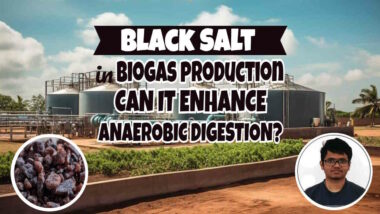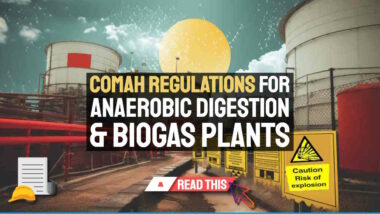We explain how the use of Biochar in Biogas Production is a symbiotic combination with a hitherto unsuspected set of benefits which by enhancing clean energy production may now be the game changer for biogas and biomethane production it always needed to become the low-cost technology of choice for massive sustainable renewable energy production.
Introducing – Biochar in Biogas Production!
The urgency to address carbon dioxide emissions has intensified efforts to generate clean energy from waste. Among many techniques, one method stands out for its efficiency and environmental benefits: Anaerobic Digestion (AD). A biological process, AD transforms organic waste into biogas. Yet, remarkable and surprising recent research shows that its full potential is only realized with the inclusion of biochar (BC).
Hardly any AD plant operators will have ever heard of this before, and yet the use of biochar in biogas production could be the final piece of the jigsaw in place for the massive expansion of the global anaerobic digestion and biogas industry.
[boomdevs_toc]
The Promise of Anaerobic Digestion (AD)
Imagine a world where our massive amount of bio-waste, from food to agricultural waste, is not just discarded but becomes a mainstream source of clean energy.
Only AD makes this vision possible.
It's a biological mechanism where microorganisms break down organic materials in an oxygen-free environment, producing biogas rich in CO2 and methane (CH4). This biogas can then be used for electricity, heating, or even fueling our vehicles. However, like many innovations, it isn't without its challenges.
The Need for Enhancement
While AD is incredibly promising, challenges like low methane productivity and system instability have hampered its widespread adoption.
Here's where (BC) Biochar in Biogas Production becomes the game changer.
Enter Biochar (Also known just as “BC”)
Biochar is essentially charred biomass and organic waste materials.
Its addition to the AD process means that biochar in biogas production can bring about a multitude of benefits, including:
- Reducing toxic inhibition
- Cutting down the methanogenic lag phase
- Immobilizing non-essential bacteria
- Boosting the electron transfer rate between key microorganisms.
Why Biochar in Biogas Production?
Compared to other materials, BC is remarkably economical, primarily because it's derived from waste biomass. It can even be made from digestate fibre!
It boasts a very high surface area, significant porosity, a rich presence of functional groups, and an outstanding electron-transferring capability. All these attributes make BC a prime candidate to enhance anaerobic methane production.
Feedstocks for Biochar Production
Biochar is versatile in its origin. It can be produced from:
- Crop residues like rice husks and wheat straw
- Forest residues including bark and sawdust
- Livestock waste such as poultry litter
- Food processing wastes, for instance, fruit peels
- Digestate solids.
Feedstock Composition Matters
The type of feedstock used in producing biochar has a direct bearing on its properties. For instance, wood-pellet BC has distinct characteristics due to its specific chemical makeup, setting it apart from others like sheep dung BC or wheat BC.
Characteristics of Biochar
BC's efficacy in the AD process is largely determined by its properties. Some of the key characteristics which make biochar in biogas production so good include:
- Pore size and volume
- Specific surface area (SSA)
- Effect on pH levels
- Elemental composition
- Electrical conductivity.
These attributes dictate how BC functions and its application in the AD process and fortunately are at the root of the success of Biochar in Biogas Production.
Biochar's Role in Anaerobic Digestion
The beauty of BC is its multifunctional role in AD:
- It promotes and regulates vital processes like methanogenesis and acidogenesis-acetogenesis
- BC is a saviour against inhibitor stress in the system
- It fosters a symbiotic relationship between fermentative bacteria and methanogens
- It also acts as a buffer capacity reinforcement agent.
A Snapshot of Biochar's Impact
To give you a clearer picture, biochar aids in:
- Increasing methane production
- Stabilizing system pH
- Promoting beneficial microbial communities
- Protecting against harmful pollutants.
A Brighter, Cleaner Future: Combating Antimicrobial Resistance in Agriculture
Low-tech, High-impact Solutions
The world of agriculture is constantly evolving, and a recent discovery promises to make a profound impact on both farm profitability and environmental health. Researchers have unearthed a simple yet highly effective way to not only enhance biomethane production but also curb the threat of antibiotic resistance from sewage and manure.
More Bang for the Buck
Utilizing low-cost conductive materials, like biochar, in anaerobic digestors has shown great promise. This approach not only supercharges biomethane output, a highly sought-after resource that can be sold, but it also presents a unique advantage – slashing the prevalence of antimicrobial resistance genes (ARGs) by a staggering 90%. That's right, a significant cut in ARGs, all while making more money from waste!
About The Pioneering Research
Mac-Anthony Nnorom, a notable environmental health researcher at the Surrey-based Centre for Environmental Health and Engineering (CEHE), spearheaded this groundbreaking review(1). He passionately remarked,
“This dual benefit of increased biomethane production and reduced ARGs from anaerobic digestion is undeniably a win-win situation. Yet, it's essential to remember this isn't the end-all solution and further research is crucial.”
The Scourge of Antimicrobial Resistance
But what exactly is antimicrobial resistance? It's when microorganisms such as bacteria and fungi evolve, rendering drugs that were once effective against them useless.
ARGs, the culprits of spreading this resistance, are alarmingly abundant in sewage sludge and animal waste. This results in these resistant genes entering and potentially harming our broader environment.
Why is This Research Vital?
The comprehensive review, published in the renowned Journal of Hazardous Materials, reveals that pig and chicken manure typically carry both a higher quantity and diversity of ARGs in contrast to cattle and sheep. Despite the considerable risks, the removal of ARGs from sewage sludge and slurry is not compulsory.
Building on Ancient Knowledge
Dr Lisa Avery, the co-author of the review, shed light on the longstanding presence of ARGs, stating,
“Although ARGs have been around even before the discovery of antibiotics and occur naturally, the rampant use of antibiotics today has drastically accelerated their evolution. Since humans and animals don't fully metabolize antibiotics, an astonishing 30-90% of any given dose ends up in the environment through sewage and slurry.”
Conclusion
While the world grapples with the looming threat of antimicrobial resistance, it's heartening to see the agricultural sector taking proactive steps to mitigate this challenge. This low-tech solution not only promises enhanced profits for farmers but also a safer environment for everyone.
Article adapted from “Low-tech sludge solution for reducing antimicrobial resistance” by the FarmingUK Team(2).
Conclusion to Biochar in Biogas Production: Its Amazing Benefits
Biochar's integration with Anaerobic Digestion offers a beacon of hope in our pursuit of clean energy.
By enhancing methane production, stabilizing systems, and promoting microbial communities, biochar is carving a niche for itself in sustainable energy solutions.
The journey towards a cleaner future is intricate, but with innovations like biochar (BC), the path becomes more than a tad clearer!
FAQ: Biochar and Anaerobic Digestion
1. What is Anaerobic Digestion (AD)?
AD is a biological process where microorganisms break down organic materials in an environment devoid of oxygen. This process produces biogas, which is rich in CO2 and methane (CH4). It's an efficient way to manage organic waste and generate clean energy.
2. How does Biochar (BC) fit into the AD process?
BC is charred biomass and waste materials. When added to the AD process, it enhances the efficiency and yield of the system. BC helps in reducing toxic inhibition, cutting down the methanogenic lag phase, immobilizing bacteria, and boosting electron transfer, among other benefits.
3. What are the sources of Biochar?
BC is versatile and can be produced from a range of materials, including crop residues like rice husks, forest residues like bark, livestock waste such as poultry litter, and food processing wastes like fruit peels.
4. Why is the type of feedstock important in BC production?
The feedstock used in producing BC directly influences its properties. Different feedstocks result in BC with varied chemical makeups, impacting its efficiency in the AD process.
5. What characteristics of BC make it suitable for the AD process?
Several key characteristics of BC contribute to its effectiveness in AD. These include its pore size, volume, specific surface area (SSA), pH levels, elemental composition, and electrical conductivity.
6. Can BC protect against harmful pollutants in the AD process?
Yes, one of BC's notable attributes is its ability to provide protection against pollutants in the AD system, making the process more stable and efficient.
7. Does BC have an economic advantage?
Definitely! Compared to other materials, BC is remarkably economical because it's derived from waste biomass. This not only promotes recycling but also offers a cost-effective solution to enhancing the AD process.
Do you have further questions?
For deeper insights into the world of Biochar and Anaerobic Digestion, consider diving into comprehensive research articles or reach out to experts in the field.
References:
- Kundu, R., Kunnoth, B., Pilli, S., Polisetty, V. R., & Tyagi, R. (2023). Biochar symbiosis in anaerobic digestion to enhance biogas production: A comprehensive review. Journal of Environmental Management, 344, 118743.
- Low-tech sludge solution for reducing antimicrobial resistance, 8 August 2023 | by FarmingUK Team – Animal Health, News






